Editorial of EPW
The killing of protesting villagers in Nandigram
by a trigger-happy police on March 14 sounds
an alarm bell that sends a warning not only to
the Left Front regime of West Bengal where the tragedy
occurred, but to all those at the helm of affairs in both the
centre and other states, who irrespective of their party
affiliation, are fond of riding roughshod over public
opposition, for the sake of “economic growth” – the
catchword in today’s official discourse of liberalisation.
The developments in Nandigram should not be treated
as something coming out of the blue. The air was already
heavy with signs of the approaching storm. The sequence
of events exposes both the political myopia of an overconfident
and arrogant ruling party and the inhuman
indifference to public concerns by its administration –
features shared in common by state governments, whether
based in Bhubaneshwar, Jaipur, Hyderabad or
Gandhinagar. When the West Bengal government initially
announced its plan to acquire land at Nandigram
for the setting up of a chemical hub, it immediately
provoked protests from among the affected villagers –
the majority of them incidentally being supporters of the
ruling CPI(M). But the party chose to ignore the signs of
discontent in Nandigram, and also failed to take lessons
from the popular outburst that had already challenged
the ham-handed efforts of its administration to acquire
land in Singur for the Tata car factory a few months
ago. Instead of correcting its past mistakes, the CPI(M)
in Nandigram persisted in ramrodding the drive for
industrialisation, without caring to take into confidence
the affected villagers. The Haldia Development Authority
(under which Nandigram falls and is headed by the local
CPI(M) MP), went ahead by issuing a circular declaring
its unilateral decision to acquire land for the project.
A smug party leadership apparently assumed that since
the villagers had voted for the Left, they would meekly
submit to the orders issued from above.
When the villagers rose in protest, chief minister
Buddhadeb Bhattacharya retracted by admitting in public
that it was a mistake, and had to announce that no land
would be taken away from them without their consent.
Yet, rather than following up the public gesture by
meeting and apologising to the disgruntled villagers and
officially withdrawing the circular, the ruling CPI(M)
seemed to have been driven by a petty vindictive motive
of teaching a lesson to their voters and dissident followers
for having dared to oppose the party’s plan. Reports by
both the media and human rights activists reveal that
in the terror that was unleashed in Nandigram on March
14 – all in the name of restoring “law and order” – the
police were accompanied by CPI(M) armed cadres who
wreaked vengeance on their opponents.
The bloody trail of terror left in Nandigram has
besmirched the image of Bhattacharya, who till recently
was basking in the glory of success in winning the
elections, regaining the confidence of Indian investors,
and earning the admiration of bhadralok Bengali society.
The Nandigram tragedy will also hang as an albatross
around the neck of his party’s central leadership which
has just begun to acquire some respectability and
importance among the Indian political classes, thanks
to the Left’s ability to win enough seats in Parliament
to influence national policies.
Beyond the immediate tragedy of Nandigram, there
lurks the more frightful prospect of increasing confrontation
all over India between state governments, which
are bent on following a particular model of development,
on the one hand, and the vast masses who are to be
dispossessed by that model, on the other. Nandigram
is only one episode among the series of agitations that
have exploded in various parts in the recent past (in
Sangrur in Punjab over acquisition of land for a special
economic zone, Kinnaur in Himachal Pradesh against
the construction of a mega hydel project and Panaji in
Goa in opposition to selling of farm and forest land to
corporate houses – to quote a few instances). L K Advani
of the Bharatiya Janata Party who is now crying hoarse
over the killings in Nandigram, chose to remain silent
992 Economic and Political Weekly March 24, 2007
over a similar happening in Kalinganagar in Orissa (where his
party is an ally of the ruling Biju Janata Dal) in January 2006,
when the police shot down 13 villagers as the local tribal
community came out in a demonstration against the appropriation
of their land for an industrial project. EPW
सीपीएम की क्रांति
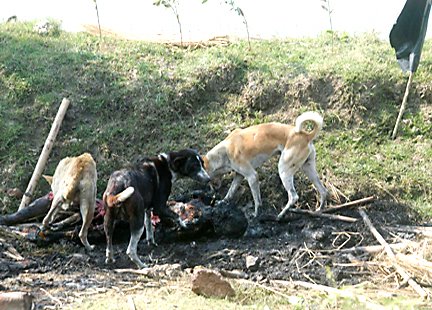
हम एक लोकतंत्र में रह रहे हैं! 14 मार्च को हुई घटना और उसके बाद सीपीएम के बंद के दौरान गायब हुए दो सौ लोगों का अब तक कोई अता-पता नहीं है्. हां। कुछ लाशें हैं जो इलाके में इस हालत में पायी गयी हैं. क्या हम बता सकते हैं कि इन्होंने किस बात की कीमत चुकायी? क्या हम इसको लेकर आश्वस्त रह सकते हं कि हमें भी कभी ऐसी ही कीमत नहीं चुकानी पड़ेगी?
Subscribe to:
Post Comments (Atom)
नंदीग्राम पर नयी फ़िल्म
यह फ़िल्म 14 मार्च की घटनाओं के सूक्ष्म विवरण के साथ आयी है.
देखें : नव उदारवाद का नया चेहरा बजरिये नंदीग्राम
देखें : विकास के नाम पर लोगों के उजड़ने की कहानी
उन्होंने मेरे पिता को टुकडों में काट डाला
देखें : न हन्यते
नंदीग्राम में 100 से ज्यादा लोग मारे गये हैं, 200 अब भी लापता हैं. वहां महिलाओं के साथ सीपीएम के कैडरों ने बलात्कार किया. बच्चों तक को नहीं छोड़ा गया है. सीपीएम की इस क्रूरता और निर्लज्जता का विरोध होना चाहिए. हमें नंदीग्राम, सिंगूर और हर उस जगह के किसानों के आंदोलन का समर्थन करना चाहिए, जो अपनी जमीन बचाने के लिए लड़ाई लड़ रहे हैं. यह दस्तावेज़ी फ़िल्म किसानों के इसी संघर्ष के बारे में है. यह फ़िल्म नंदीग्राम के ताज़ा नरसंहार से पहले बनायी गयी थी.
नंदीग्राम में जनसंहार के बाद के द्श्य
यह फिल्म पुलिस द्वारा नंदीग्राम में बर्बर तरीके से की गयी हत्याओं एवं उनकी भयावहता व बर्बरता के बारे में है. इसके कई दृ़श्य विचलित कर देनेवाले हैं.
नंदीग्राम प्रतिरोध्
नंदीग्राम में सरकारी आतंक
देखें : माकपा की गुंडागर्दी
नंदीग्राम में सीपीएम सरकार की पुलिस ने जो बर्बर कार्रवाई की, वह अब खुल कर सामने आने लगी है. यह फ़िल्म उसी बर्बरता के बारे में है. इसके कई दृश्य आपको विचलित कर सकते हैं. आप इसे तभी देखें जब आप वीभत्स दृश्य देख सकने की क्षमता रखते हों. हम खुद शर्मिंदा हैं कि हमें ऐसे दृश्य आपको दिखाने पड़ रहे हैं, पर ये आज की हकीकत हैं. इनसे कैसे मुंह मोडा़ जा सकता है?

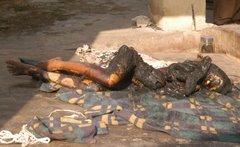
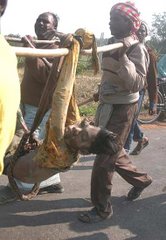
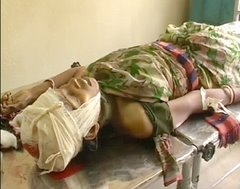

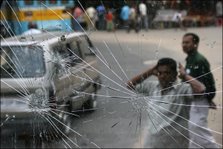
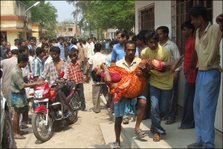

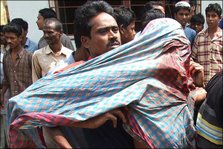


No comments:
Post a Comment